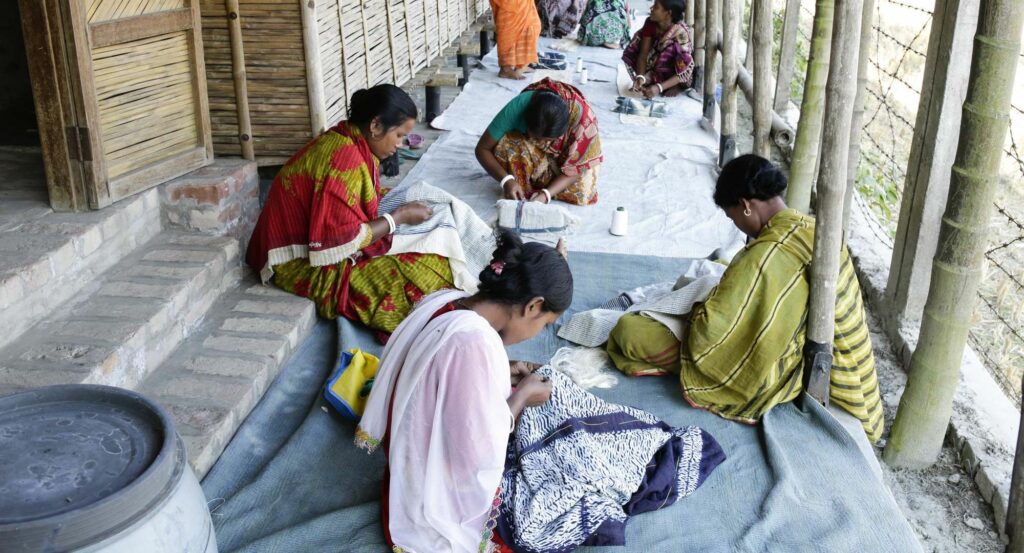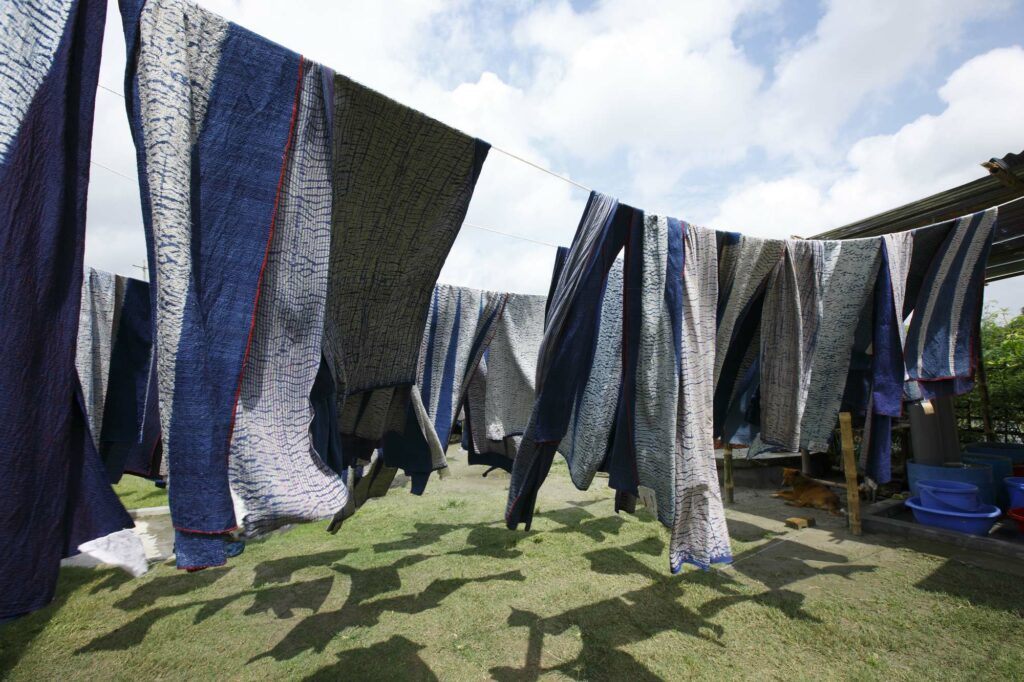IN CONVERSATION WITH MURTAZA JAHANGIR: about Authentic Bengal Indigo – PART I

(12 Minutes Read)
Living Blue has placed Bangladesh on the map of natural Indigo dye producing countries. It originally started as a governance project of CARE Bangladesh in 2005, later the mother organization of Living Blue, Nijera Cottage and Village Industries was formed in 2006. Through this project, the process of indigo cultivation and indigo dye production was revived in Rangpur, a northern district in Bangladesh. Now working with more than 3000 indigo farmers and 200 artisans and dyers, Living Blue operates as a social business- that is owned and run by the participating communities in collaboration with BRAC Bangladesh.
Indigo dye produced by Living Blue is considered one of the best quality natural Indigo and is marketed and sold worldwide. Murtaza Jahangir, the Technical Manager of Living Blue, shares his journey with Artisan Social. He shares his day-to-day challenges, strength and success stories of working with some of the leading designers in Europe. During the COVID-19 lock down, in an online face-to-face interview, Murtaza Jahangir shares his experience.
AS- How are you coping with the COVID 19 pandemic while working with the artisans at Living Blue? How has it affected the day to day operations at the atelier?
MJ- The artisans have been affected from two sides, both primary and the secondary source of their income have been disrupted by the Covid-19 pandemic. The men are considered the primary bread earners in these communities. The women artisans who work as a secondary income source with Living Blue, were also unable to participate as well. Since the early days of lock down, none of the earning members of the family could go to work, they suffered major income shortage.
To address this situation, with the specific guidelines provided by CARE Bangladesh, the work was resumed immediately after the lock down was eased officially. A roster was developed carefully to ensure the safety and security of the workers. We work with two types of artisans. One group participates by coming to the atelier and working on the spot and another group works from home. The artisans who work at the studio were affected the most during this time. To ease their financial hardship, the atelier-based artisans are now allowed to come every alternative day so we are working with a fifty percent capacity. They work in open areas with lots of natural light and air. The artisans are stationed sparsely on the outdoors corridor of the atelier to maintain proper social distancing and access to open air. They also must follow other health and safety measures while working. The supervisors carefully ensure that everyone follows the WHO issued safety instructions and guidelines.
The aftermath of the pandemic on the business side of things, is of course yet to be seen in the coming days. The pandemic has affected the entire spectrum of the market and the trend shows that people are mostly spending on bare necessities and essentials. We are suspecting that the luxury product market will be adversely affected. So our business with luxury brands and high-end fashion designers might be uncertain and disrupted. In which capacity the future businesses will resume and continue is yet to be seen.
AS- What are the criteria for participation at Living Blue as an artisan? How many categories of participants are there?
MJ- To answer your question clearly, I need to go into the history behind the formation of Living Blue. As you probably know, Living Blue started as a part of a Governance project of CARE Bangladesh. One of the criteria of the program was to engage with people living in extreme poverty. Particularly, with families earning less than a dollar a day. The artisans of Living Blue are mostly continuation of those participants from the project. The communities were expected to come up with their own problems they needed support with. In the Northern region of Bangladesh, some of the districts go with long periods of drought and lean productivity. As a result the communities suffer periodically with their income and occupation. The communities wanted a year round occupation and stable income.
After substantial research and exploration, a project was structured based on available local skill and resources. The indigo plant was recognised as a native plant from the area. During the British ruling period indigo plantation was done vastly in this region. The torture and the brutality associated with the plantation workers by the ruling class was so horrific that it put the indigo plantation to go extinct. The plant however survived and was forgotten by the generations afterwards. As a part of the income generation project, the indigo plant was re-recognized and cultivation and extraction was further developed to revive the indigo. A business model was put in place to ensure year-round income generating activities for the participants.
The women in the community had the traditional sewing and kantha making skills but they did not participate in any income generation activity, as of yet. The men could do indigo cultivation during the lean-periods when there were no food crops to be grown. The indigo plant was used to fertilize the lands naturally in between the two food crops grown yearly. Considered as species of weeds, the indigo did not need a lot of care or water. For the landless farmers who usually work as a day-labourer, remain unemployed during these three months of no food-crops production. They go through a time of hardship during these months. These farmers can successfully engage in indigo extraction and processing during the lean months. Some farmers were trained to do the task and since then, with the humble production of fourteen kilograms of Indigo in the first year Living Blue started its journey. Currently, with the consultation of the Agricultural University and the Agricultural Experts from CARE we have a set up of a commercial production unit to produce up to one and half tons of Indigo every year.
The Indigo dye recipe was developed with the guidelines provided by Syeda Ruby Ghuznavi, one of the leading natural dye experts from the subcontinent. We hired a consultant to help our artisans to learn the shibori techniques to further enhance their skill sets. So the local kantha making skills, shibori techniques and indigo dye-the combination of these three set our USP in the market.
However, today the participants are selected on the basis of their interest and willingness. When a new artisan joins the kantha making team, she is assigned with a master kantha artisan. The new participant can learn about the standards of Living blue craftsmanship and about the high quality. For example, on a blanket we use seven to eight stitches per inch while quilting, on the other hand for stoles and fashion pieces, made with silk, we use upto thirteen or fourteen stitches. As a part of this on-the-job training program the skills of the new artisans are fine-tuned.
AS- What is a typical day at the Living Blue atelier in Rangpur – please give our readers an idea.
MJ-Even though we say that the working hours are nine to five, it is a bit of an overstatement. Only the core level managers go to the office at nine and open the atelier for the day. Our artisans start coming to the office following that and by the time they complete daily protocols and sit down for work, it’s actually around ten. We try not to put any pressure on the women artisans because we also value and respect their primary responsibilities at home. The artisans who start with a new task, they get their directions from the production managers and the others continue with their work in hand from the previous day.
The role of the production manager is to decide on fabrics, the patterns for a specific order, the overall coordination of the operations. Based on a Gantt Chart they work according to various schedules for productions. There are supervisors in the dyeing and shibori section who assist the production manager with the overall coordination of the orders. Quilting supervisor takes care of the work related to quilting. His responsibilities include but not limited to cutting fabrics, quality assurance and follow up with work. One of the major tasks of the quilting supervisor is to distribute the work amongst the home-based artisans, to pay them visits for supervision and to collect the completed work. In order to avoid delays or any last minute defects and to make sure that the product is getting made according to the exact specification- the quality assurance has to be done with more frequency and vigor for the home-based artisan.
They work until lunch break at one pm, many of them live close by so they go home to have lunch and come back after an hour and continue with their work. The work day depends basically on the availability of sunlight. Since most of the shibori and stitch artisans work with natural daylight, as soon as the sunlight is inadequate, their work day is basically completed. During the short winter days, we adjust the work hours accordingly.
AS- When you have visitors or when you go for work to Rangpur, where do you stay? Do you have living quarters or a guest house?
MJ- We do not have a guest house owned by Living Blue or CARE Bangladesh. When we visit for work and when we have visitors we stay in a wonderful facility operated and owned by an NGO (RDRS). It is a good facility with all necessary amenities.
